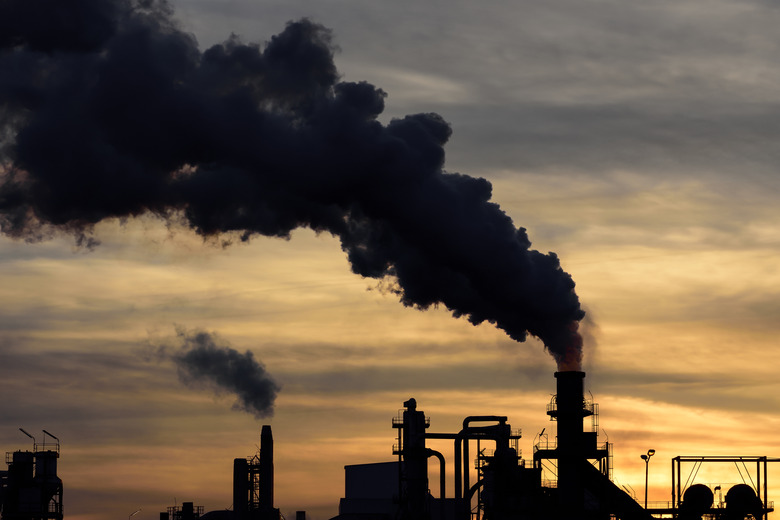What Pollutes The Air?
Air pollution is caused by humans introducing chemicals and other materials into the air. These pollutants are dangerous to both the environment and our own health. Air pollution has a wide range of effects from respiratory disease to climate change. Understanding the causes and effects of air pollution is essential to making a difference in the way we care for our air.
Significance
Significance
There are six common air pollutants which threaten our health and environment. These are classified as ozone, particulate matter, carbon monoxide, nitrogen dioxide, sulfur dioxide, and lead. The Environmental Protection Agency tracks each of these pollutants in two ways. First, they measure the concentrations of these pollutants in the outside air. Second, they track the engineering estimates of emissions released into the air each year. Urban areas usually see the worst air pollution. Ozone is usually heaviest in cities, and is especially dangerous in summertime. Between 85 and 95 percent of carbon monoxide emissions in large cities are caused by motor vehicles. This type of air pollution is much more prevalent in heavily populated areas.
Types
Types
Ozone is one of the most well-known types of air pollution. Ozone is caused by vehicle exhaust, industrial emissions, chemical solvents, and gasoline vapors. Hot weather and sunlight are also factors which, when combined with the emissions above, create high concentrations of ozone in the air. Particulate matter is any mixture of tiny particles of acids, chemicals, metals, dust, and soil. There are two types of particulate matter: inhalable coarse particles, and fine particles. Inhalable course particles can come from dusty industrial plants or roadways. Fine particles can be found in haze and smoke. These are often created by reactions between various industrial emissions, power emissions, and vehicle emissions. Carbon monoxide is a dangerous gas created when the carbon present in fuel is not burned completely. About 56% of carbon monoxide emissions are caused by motor vehicles, and another 22% are caused by other types of vehicles. Certain kinds of manufacturing, gas stoves and space heaters, and even cigarette smoke all contribute to carbon monoxide emissions. Nitrogen oxides consist of a variety of reactive gases containing both nitrogen and oxygen. One of the most common is nitrogen dioxide. Nitrogen dioxide can actually be seen by the human eye and appears as a reddish-brown haze over heavily polluted urban areas. Sulfur dioxide is a gas formed by various actions concerning crude oil, ore, and coal. The burning of coal and oil releases sulfur dioxide, as does the process used to extract various metals from ore. Lead emissions are caused by various manufacturing processes including lead smelters and lead-acid battery manufacturing as well as waste incineration.
History
History
Air pollution has naturally evolved along with society. The earth is capable of neutralizing small amounts of air pollution, but rapid industrialization and an ever-growing human population have resulted in levels of air pollution that the planet can not handle. Though most people only consider vehicle and industrial emissions when they think about air pollution, the air inside most homes and offices is often more polluted then the air outside. Mold, glue, paint, vinyl, and linoleum are all indoor air pollutants as well as cleaning solutions, cigarette smoke, and electrical cables. Poor air ventilation often traps the polluted air inside.
Effects
Effects
Air pollution is linked to a variety of problems related to the respiratory system and cardiovascular system. Approximately 2.4 million fatalities are caused by air pollution each year. This pollution is especially harmful to children who can develop severe cases of asthma and pneumonia as well as lower respiratory infections. With particulate matter, the smaller it is, the more dangerous it is to human health. Particulate matter that is inhaled can cause serious health problems with the heart and lungs. An estimated 500,000 American deaths each year are caused by fine particle air pollution.
Prevention/Solution
Prevention/Solution
Lead emissions are one area of air pollution that has seen a dramatic reduction. Lead emissions were historically caused by motor vehicles. The Environmental Protection Agency made a strong effort to remove lead from gasoline. This initiative reduced lead emissions from transportation by 95% between 1980 and 1999. This in turn reduced the amount of lead emissions present in the air by about 94% in the same time period. There are several initiatives in place today to continue dealing with rising levels of air pollution. Increased fuel efficiency is one way to reduce the air pollution caused by motor vehicles. Bioethenol and biodiesel are some of the cleaner fuels which are being developed to deal with this problem as well. A better educated society may help us to work globally to find solutions. It is important for the health of people and the planet that actions are taken to reduce air pollution.
Cite This Article
MLA
Rogier, Mandi. "What Pollutes The Air?" sciencing.com, https://www.sciencing.com/what-pollutes-the-air-13635701/. 17 November 2008.
APA
Rogier, Mandi. (2008, November 17). What Pollutes The Air?. sciencing.com. Retrieved from https://www.sciencing.com/what-pollutes-the-air-13635701/
Chicago
Rogier, Mandi. What Pollutes The Air? last modified August 30, 2022. https://www.sciencing.com/what-pollutes-the-air-13635701/
